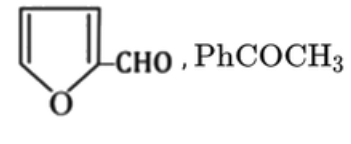How many of these molecules can have any type of hydrogen bonding.
Glucose, HF, −OH,R−COOH,R2NH,CCl3CHO,Ph−Br, o - nitro phenol,PH3.
The correct Answer is:7.00
To determine how many of the given molecules can exhibit hydrogen bonding, we will analyze each molecule one by one. Hydrogen bonding occurs when a hydrogen atom is covalently bonded to a highly electronegative atom (like O, N, or F) and is attracted to another electronegative atom.
1. Glucose (C₆H₁₂O₆):
- Glucose has multiple hydroxyl (-OH) groups. Each hydroxyl group can form hydrogen bonds with other molecules.
- Conclusion: Glucose can participate in hydrogen bonding.
2. HF (Hydrogen Fluoride):
- HF is a classic example of hydrogen bonding. The hydrogen atom is bonded to fluorine, which is highly electronegative.
- Conclusion: HF can participate in hydrogen bonding.
3. R-OH (Alcohol):
- Alcohols have hydroxyl groups (-OH) that can form hydrogen bonds with other alcohol molecules or with water.
- Conclusion: R-OH can participate in hydrogen bonding.
4. R₂NH (Secondary Amine):
- In secondary amines, the nitrogen atom has a lone pair and is bonded to two alkyl groups and one hydrogen. The hydrogen can form hydrogen bonds with electronegative atoms.
- Conclusion: R₂NH can participate in hydrogen bonding.
5. RCOOH (Carboxylic Acid):
- Carboxylic acids contain a carboxyl group (-COOH) which can form strong hydrogen bonds due to the presence of both a carbonyl (C=O) and a hydroxyl (O-H) group.
- Conclusion: RCOOH can participate in hydrogen bonding.
6. CCl₃CHO (Trichloroacetaldehyde):
- This molecule has a carbonyl group (C=O) and a hydrogen atom attached to the carbon. The hydrogen can participate in hydrogen bonding with other electronegative atoms.
- Conclusion: CCl₃CHO can participate in hydrogen bonding.
7. Ph-Br (Bromobenzene):
- Bromobenzene does not have any hydrogen atoms bonded to highly electronegative atoms. Therefore, it cannot participate in hydrogen bonding.
- Conclusion: Ph-Br cannot participate in hydrogen bonding.
8. o-Nitrophenol:
- o-Nitrophenol has a hydroxyl group (-OH) and a nitro group (-NO₂) which can facilitate intramolecular hydrogen bonding. The hydrogen of the hydroxyl can bond with the oxygen of the nitro group.
- Conclusion: o-Nitrophenol can participate in hydrogen bonding.
9. PH₃ (Phosphine):
- PH₃ does not have highly electronegative atoms bonded to hydrogen, and thus it does not exhibit hydrogen bonding.
- Conclusion: PH₃ cannot participate in hydrogen bonding.
Summary of Findings:
- Molecules that can participate in hydrogen bonding: Glucose, HF, R-OH, R₂NH, RCOOH, CCl₃CHO, o-Nitrophenol.
- Molecules that cannot participate in hydrogen bonding: Ph-Br, PH₃.
Total Count:
- Total molecules that can exhibit hydrogen bonding = 7 (Glucose, HF, R-OH, R₂NH, RCOOH, CCl₃CHO, o-Nitrophenol).
Final Answer:
7 molecules can have any type of hydrogen bonding.
---
- Glucose has multiple hydroxyl (-OH) groups. Each hydroxyl group can form hydrogen bonds with other molecules.
- Conclusion: Glucose can participate in hydrogen bonding.
- HF is a classic example of hydrogen bonding. The hydrogen atom is bonded to fluorine, which is highly electronegative.
- Conclusion: HF can participate in hydrogen bonding.
- Alcohols have hydroxyl groups (-OH) that can form hydrogen bonds with other alcohol molecules or with water.
- Conclusion: R-OH can participate in hydrogen bonding.
- In secondary amines, the nitrogen atom has a lone pair and is bonded to two alkyl groups and one hydrogen. The hydrogen can form hydrogen bonds with electronegative atoms.
- Conclusion: R₂NH can participate in hydrogen bonding.
- Carboxylic acids contain a carboxyl group (-COOH) which can form strong hydrogen bonds due to the presence of both a carbonyl (C=O) and a hydroxyl (O-H) group.
- Conclusion: RCOOH can participate in hydrogen bonding.
- This molecule has a carbonyl group (C=O) and a hydrogen atom attached to the carbon. The hydrogen can participate in hydrogen bonding with other electronegative atoms.
- Conclusion: CCl₃CHO can participate in hydrogen bonding.
- Bromobenzene does not have any hydrogen atoms bonded to highly electronegative atoms. Therefore, it cannot participate in hydrogen bonding.
- Conclusion: Ph-Br cannot participate in hydrogen bonding.
- o-Nitrophenol has a hydroxyl group (-OH) and a nitro group (-NO₂) which can facilitate intramolecular hydrogen bonding. The hydrogen of the hydroxyl can bond with the oxygen of the nitro group.
- Conclusion: o-Nitrophenol can participate in hydrogen bonding.
- PH₃ does not have highly electronegative atoms bonded to hydrogen, and thus it does not exhibit hydrogen bonding.
- Conclusion: PH₃ cannot participate in hydrogen bonding.
- Molecules that can participate in hydrogen bonding: Glucose, HF, R-OH, R₂NH, RCOOH, CCl₃CHO, o-Nitrophenol.
- Molecules that cannot participate in hydrogen bonding: Ph-Br, PH₃.
- Total molecules that can exhibit hydrogen bonding = 7 (Glucose, HF, R-OH, R₂NH, RCOOH, CCl₃CHO, o-Nitrophenol).
7 molecules can have any type of hydrogen bonding.
Topper's Solved these Questions
Similar Questions
Knowledge Check
Which of the following compounds would have significant intermolecular hydrogen bonding?
HF,CH3OH,N2O4,CH4AHF,N2O4BHF,CH4,CH3OHCHF,CH3OHDCH3OH,CH4Compounds showing hydrogen bonding among HF,NH3,H2SandPH3 are
Aonly HF,NH3andPH3BonlyHFandNH3COnly NH3,H2SandPH3DAll four show hydrogen bondingPure samples of which of the following exhibit hydrogen bonding?
(P) CH3OH
(Q) CH3NO2
(R) CH3CNAP onlyBP and Q onlyCQ and R onlyDP, Q , R
How many of these compounds can undergo Cannizzaro reaction here
CH3CHO,CH3COCH3,HCHO,Ph−CHO,Ph−CO−CHO,
 , PhCOCH3
, PhCOCH3
View SolutionHow many of these compounds can reduce Tollen's reagent here?
HCHO,Ph−CHO,Ph−COCH3,CH3COCH3,CH3−C∣∣OH2OH
Glucose, CH3CH2OH
View SolutionHow many of the following has hydrogen bonding
(a) NH3 , (b) CH4 , (c) H2O
(d) HI , (e) HF , (f) HCOOH
(g) B(OH)3 , (h) CH3COOH , (i) HCO3−ion
View SolutionHow many of the following groups are ortho,para directing and ring activating?
−NO2,−CN,−CH3,−OH,−NH2,
−OR,−X,−CHO,−NHR
View SolutionHow many of the following contains "H" bonding in their liquid state?
ethyl alcohol,H2O,NH3,HF, HCl, methyl amine, Phenol, diethyl ether
View Solution

 ,
,